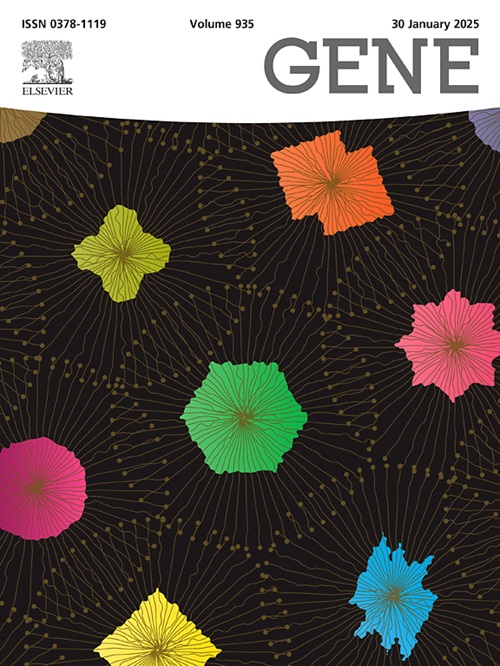基于免疫相关糖基化基因的分类可预测骨肉瘤的预后和治疗方案。
IF 2.6
3区 生物学
Q2 GENETICS & HEREDITY
引用次数: 0
摘要
骨肉瘤是最常见的原发性骨恶性肿瘤,预后极差。骨肉瘤与糖基化异常关系密切。因此,本研究旨在探讨糖基化基因在骨肉瘤预后和治疗方案中的作用。研究采用估计算法评估了骨肉瘤的微环境。通过皮尔逊相关分析,共鉴定出20个免疫相关糖基化基因(IRGGs)。据此,骨肉瘤患者通过共识聚类被分为C1和C2型。应用多种算法(Xcell、MCP-counter、ssGSEA、epic、quantiseq)、癌症免疫周期分析和GSVA估测骨肉瘤的免疫、分子和代谢特征,结果表明C1型骨肉瘤具有高免疫浸润、高糖基化、富含MEK信号和预后好的特点,而C2型骨肉瘤具有多转移、富含免疫治疗阳性基因特征、高肿瘤突变负荷和预后差的特点。TIDE算法和免疫治疗数据集的结果表明,C2型偏好免疫检查点抑制剂(ICIs),而GDSC、CMap分析和细胞实验数据表明,C1型对MEK抑制剂PD0325901敏感。此外,单变量 Cox 分析和 Lasso 分析相结合,建立了包含 6 个基因(B3GNT8、FUT7、GAL3ST4、GALNT14、HS3ST2 和 MFNG)的 IRGGs 风险评分。DCA 和 ROC 的数据表明,它能很好地预测骨肉瘤的预后。最后,细胞定位分析表明,这 6 个基因不仅分布在肿瘤细胞中,也分布在免疫细胞中。总之,基于IRGGs的分类和风险评分能有效预测骨肉瘤的预后和治疗方案。对IRGGs的进一步研究可能有助于了解骨肉瘤的癌症免疫。本文章由计算机程序翻译,如有差异,请以英文原文为准。
Immune-related glycosylation genes based classification predicts prognosis and therapy options of osteosarcoma
Osteosarcoma is the most common primary bone malignancy, with a very poor prognosis. Aberrant glycosylation is close involvement in osteosarcoma. Accordingly, this study aimed at investigating the role of glycosylation genes in the prognosis and therapy options of osteosarcoma. The microenvironment of osteosarcoma was assessed using estimate algorithm. A total of 20 immune-related glycosylation genes (IRGGs) was identified using Pearson correlation analysis. Accordingly, osteosarcoma patients were divided into C1 and C2 type using consensus clustering. Multiple algorithms (Xcell, MCP-counter, ssGSEA, epic, quantiseq), cancer immune cycle analysis, and GSVA were applied to estimate the immune, molecule and metabolism characteristics of osteosarcoma, indicating that C1 type was featured with high immune infiltration, high glycosylation, enriched MEK signaling, and good prognosis, while C2 type was characterized by more metastasis, enriched immunotherapy-positive gene signatures, high tumor mutation burden, and poor prognosis. Results from TIDE algorithm and immunotherapy datasets suggested the C2 type’s preference of immune checkpoint inhibitors (ICIs), while data of GDSC, CMap analysis and cell experiments indicated that C1 type was sensitivity to MEK inhibitor PD0325901. In addition, univariate Cox and Lasso analysis was combined to establish an IRGGs’ risk score containing 6 genes (B3GNT8, FUT7, GAL3ST4, GALNT14, HS3ST2, and MFNG). The data of DCA and ROC indicated its well prediction of prognosis in osteosarcoma. Finally, cellular location analysis showed that the 6 genes not only distributed in tumor cells but also in immune cells. In summary, the classification and risk score based on IRGGs effectively predicted the prognosis and therapy options of osteosarcoma. Further studies on IRGGs may contribute to the understanding of cancer immunity in osteosarcoma.
求助全文
通过发布文献求助,成功后即可免费获取论文全文。
去求助
来源期刊

Gene
生物-遗传学
CiteScore
6.10
自引率
2.90%
发文量
718
审稿时长
42 days
期刊介绍:
Gene publishes papers that focus on the regulation, expression, function and evolution of genes in all biological contexts, including all prokaryotic and eukaryotic organisms, as well as viruses.
 求助内容:
求助内容: 应助结果提醒方式:
应助结果提醒方式:


